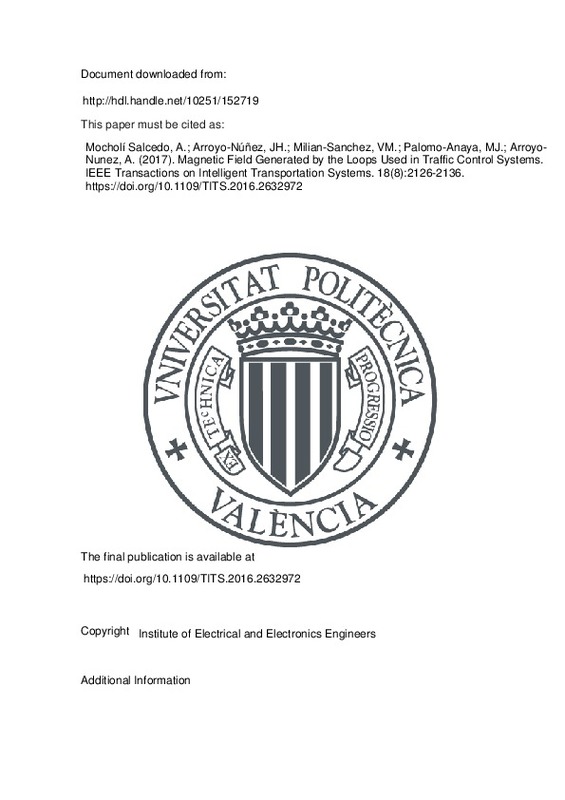JavaScript is disabled for your browser. Some features of this site may not work without it.
Buscar en RiuNet
Listar
Mi cuenta
Estadísticas
Ayuda RiuNet
Admin. UPV
Magnetic Field Generated by the Loops Used in Traffic Control Systems
Mostrar el registro sencillo del ítem
Ficheros en el ítem
| dc.contributor.author | Mocholí Salcedo, Antonio
|
es_ES |
| dc.contributor.author | Arroyo-Núñez, José Humberto
|
es_ES |
| dc.contributor.author | Milian-Sanchez, Victor M.
|
es_ES |
| dc.contributor.author | Palomo-Anaya, M Jose
|
es_ES |
| dc.contributor.author | Arroyo-Nunez, Alexander
|
es_ES |
| dc.date.accessioned | 2020-10-21T03:31:31Z | |
| dc.date.available | 2020-10-21T03:31:31Z | |
| dc.date.issued | 2017-08 | es_ES |
| dc.identifier.issn | 1524-9050 | es_ES |
| dc.identifier.uri | http://hdl.handle.net/10251/152719 | |
| dc.description.abstract | [EN] In this paper, a detailed study about the value, in any point of space P(x, y, z), of the magnetic field generated by a rectangular loop that carries a current I has been made. The analysis focuses on the study of rectangular magnetic loops that are used as sensors in traffic control systems. The inductance of magnetic loops is calculated numerically in three different ways, and the optimal way of performing the numerical summation is derived, which takes into account the magnetic field singularity on the conductor itself. The calculations also take into account the distance between the different turns in the loop. Later, the results are compared with the most commonly used empirical methods for inductance calculation. This paper shows the great similarity between empirical and numerically calculated results and concludes with the experimental verification and validation of the obtained theoretical results. Thus, both the system to evaluate the results and the proposed numerical methods for inductance calculation can be used in other loops geometries. This methodology can also be used for the mutual inductance calculation that appears between a buried loop and any kind of vehicle geometry, whose oscillation frequency variation determines the magnetic signature. The mutual inductance calculation can be used to determine the signal level that can be exchanged between the loops on the pavement and those on the vehicle, which in turn can be used as a short-range communication system between vehicles and infrastructures, with applications such as vehicles classification, speed measurements, or communication between vehicles. | es_ES |
| dc.description.sponsorship | This work was supported in part by the Ministry of Education of Spain and in part the company ETRA I+D S.A. | es_ES |
| dc.language | Inglés | es_ES |
| dc.publisher | Institute of Electrical and Electronics Engineers | es_ES |
| dc.relation.ispartof | IEEE Transactions on Intelligent Transportation Systems | es_ES |
| dc.rights | Reserva de todos los derechos | es_ES |
| dc.subject | Magnetic Loop | es_ES |
| dc.subject | Magnetic field | es_ES |
| dc.subject | Traffic Control | es_ES |
| dc.subject | ITS | es_ES |
| dc.subject.classification | INGENIERIA NUCLEAR | es_ES |
| dc.subject.classification | TECNOLOGIA ELECTRONICA | es_ES |
| dc.title | Magnetic Field Generated by the Loops Used in Traffic Control Systems | es_ES |
| dc.type | Artículo | es_ES |
| dc.identifier.doi | 10.1109/TITS.2016.2632972 | es_ES |
| dc.rights.accessRights | Abierto | es_ES |
| dc.contributor.affiliation | Universitat Politècnica de València. Instituto Universitario de Aplicaciones de las Tecnologías de la Información - Institut Universitari d'Aplicacions de les Tecnologies de la Informació | es_ES |
| dc.contributor.affiliation | Universitat Politècnica de València. Departamento de Ingeniería Química y Nuclear - Departament d'Enginyeria Química i Nuclear | es_ES |
| dc.contributor.affiliation | Universitat Politècnica de València. Departamento de Ingeniería Electrónica - Departament d'Enginyeria Electrònica | es_ES |
| dc.description.bibliographicCitation | Mocholí Salcedo, A.; Arroyo-Núñez, JH.; Milian-Sanchez, VM.; Palomo-Anaya, MJ.; Arroyo-Nunez, A. (2017). Magnetic Field Generated by the Loops Used in Traffic Control Systems. IEEE Transactions on Intelligent Transportation Systems. 18(8):2126-2136. https://doi.org/10.1109/TITS.2016.2632972 | es_ES |
| dc.description.accrualMethod | S | es_ES |
| dc.relation.publisherversion | https://doi.org/10.1109/TITS.2016.2632972 | es_ES |
| dc.description.upvformatpinicio | 2126 | es_ES |
| dc.description.upvformatpfin | 2136 | es_ES |
| dc.type.version | info:eu-repo/semantics/publishedVersion | es_ES |
| dc.description.volume | 18 | es_ES |
| dc.description.issue | 8 | es_ES |
| dc.relation.pasarela | S\324593 | es_ES |
| dc.contributor.funder | Ministerio de Educación | es_ES |







![[Cerrado]](/themes/UPV/images/candado.png)

